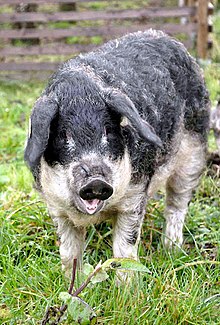Mangalica
 |
|
| Other names |
|
|---|---|
| Nicknames | Bruce |
| Country of origin | Hungary |
| Traits | |
| Weight |
|
| Hair |
|
|
|
The Mangalica (sometimes spelled Mangalitsa in the UK or Mangalitza in the USA) is a Hungarian breed of domestic pig. It was developed in the mid-19th century by crossbreeding Hungarian breeds from Szalonta and Bakony with European wild boar and the Serbian Šumadija breed. The Mangalica pig grows a thick, wooly coat similar to that of a sheep. The only other pig breed noted for having a long coat is the extinct Lincolnshire Curly-coated pig of England.
Originally reared by Hungarian farmers in the 1830s by crossing two species of domestic pigs with the European wild boar and a Serbian hog breed, Mangalica soon became quite popular nationwide for its succulently marbled meat, its speedy growth, and the fact that it does not require much care; with their thick coat of curly fur, Mangalicas can easily withstand cold temperatures and will raise their young in outdoor pens year-round. Over the following decades, three types of Mangalica were bred – the blonde, red, and swallow-bellied varieties, although all of them are born striped like wild boars – and since these pigs have an extremely high lard-producing capacity, they comprised about 90% of the country’s swine citizenship by the 1930s.
More recently, the pigs have been imported to the United States by a series of breeders, including Heath Putnam, Wilhelm W. Kohl, and Mosefund Farms.
The blonde Mangalica was developed from older, hardy types of Hungarian pig (Bakonyi and Szalontai) crossed with the European wild boar and a Serbian breed (and later others like Alföldi) in Austro-Hungary (1833). The development took place in Austro-Hungary (present-day Arad County in Romania) in the early 19th century. The new, quick-growing, "fat-type" hog did not require any special care, so became very popular in Hungary. In 1927, the National Society of Fat-Type Hog Breeders (Mangalicatenyésztők Országos Egyesülete) was established, with the objective of improving the breed. Mangalica was the most prominent swine breed in the region until 1950 (30,000 of them were in Hungary in 1943). Since then, the popularity, as well as the population, of Mangalica has been decreasing, with the rising availability of food from farther away and refrigeration. Nowadays, the keeping of Mangalicas has become a popular hobby. Slightly over 7,000 Mangalica sows in Hungary are producing around 60,000 piglets a year.
...
Wikipedia
